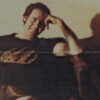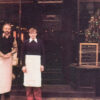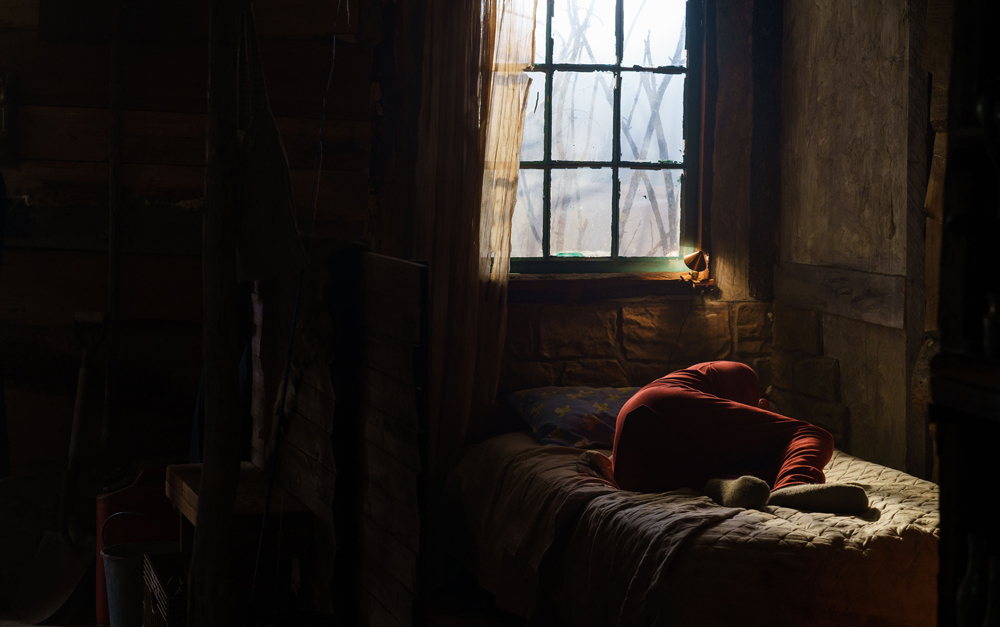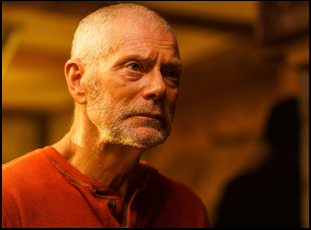“It’s nice when you’re lost and somebody can help you find your way,” the titular character (Stephen Lang) of “Old Man” tells Joe (Marc Senter), a rare visitor to his cabin far from civilization. It strikes the recluse as curious how Joe got so off-track as to come knocking at his door, but as he engages him in an increasingly strange conversation, you begin to wonder which of the two has really wandered off the reservation in the latest potboiler from Lucky McKee, who needs no more than a pair of actors on point and a raging snowstorm outside for a taut thriller.
The director of “May” and “The Woman”finds there’s plenty of ground to cover as Lang’s crotchety coot attempts to suss out Joe’s real reasons for darkening his doorstep while half-enjoying the rare occasion of having company, especially when his dog Rascal has seemingly disappeared recently without leaving a trace. But it becomes clear he had reasons for moving so far away from other people and with both brusque social skills and the emergence of increasingly troubling revelations as he interrogates Joe, leaving him with much to answer for himself, “Old Man” doesn’t miss a trick as Lang and Senter make for worthy sparring partners and Joel Veach’s script is full of surprising turns. With the film arriving in theaters and on demand this week, McKee spoke about how he managed such a crafty shoot in the midst of a pandemic, setting the mood on set to enable the actors to get to the places they needed to go emotionally and the old school filmmaking touches that make the film feel fresh.
I’ve known Marc Senter for years because I produced a film that he’d acted in called “The Lost,” that my buddy Chris Sivertson directed and I’d directed him in an anthology film I made called “Tales of Halloween,” and over the years, we always wanted to work on a feature together. We wanted to have that full meal because we both had a real strong connection as friends and collaborators, and Marc’s friend Joel Veach had written this play that he had turned into a script and he gave it to me. I had an instant personal connection to this old man and this environment since I grew up in a rural environment and was around a lot of characters like this, so I felt like there was a lot of truth in the script. I was excited to explore that and collaborate with Marc and Joel and our friend Aaron Koontz and his production company came on board, and we just set about making the thing at the height of the pandemic in upstate New York in the dead of winter.
That sounds like an even bigger challenge than on the face of it when it’s so dynamic for a single location film. Was it intimidating?
That’s part of what attracted me to it, that challenge of how do you keep things cinematic when you’re that limited to the environment. In all of my films throughout the years, the primary thing is to display interesting characters, and there was two very interesting characters on the page there, so it became our job to create the correct atmosphere around them and could add to the dramatic qualities of the script. Beyond that, it became about just making it a showcase for two great performances, and that was so fun to dive into – to just let these guys just go to all sorts of crazy emotional places, and to try to get the camera in the right place to capture that in the best possible light.
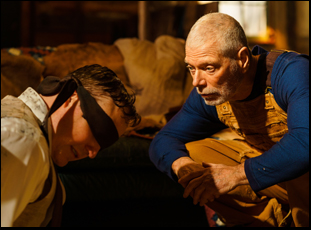
It was so fun. One of the great advances in film technology is LED lighting, and we built this set, and in prep we were able to arrange all the lights and set everything before we started filming to where it’s like you could literally go over to a laptop and say, “I need this time of day or I need that time of day,” and the color temperature would change. Now, there’s no longer people putting gels over light and running up and down ladders. You can program any color you want. You can have the lights change and move within a shot and that technology I think is one of the biggest leaps forward in the way we make films.
I have a director of photography that has a wonderful eye in Alex Vendler, who’s shot several movies for me, including “The Woman,“ and we looked at painters that we really liked and were trying to emulate the lighting that we’d see in Andrew Wyeth paintings, so it was just a mixture of our experience, and also just what in our guts felt like the appropriate thing to do for what was happening dramatically.
The performances are always extraordinary in your films, and both actors get to show off their range so much. How much is that a collaboration in figuring out the character versus letting the actors go off and do their own thing and come back with something?
Film is collaboration, and anybody that reads a screenplay is going to have a different interpretation of it, but it’s when you find those actors that their interpretation of it is adding something to it or elevating it in some way. Both Stephen Lang and Marc Senter were bringing a lot to it and as the director, it’s my job to respect that, but also to filter through that and make suggestions about, “Oh, well, maybe that’s too far, or maybe that’s not far enough. Are we really pushing ourselves with this?” The art form is collaboration, and it’s about working with people that you have a connection with on a personal and a professional level and I just happened to just have that – our views on the character were very aligned, and at the same time, we were constantly working to just elevate the material as much as we could, off of a brilliant script by Joel.

He was the right age range and he’s played so many different kinds of parts over the years, but he also had heavy, heavy roots in the theater, so he’s an actor that doesn’t just memorize his sides for that day or his couple scenes, but the whole script, and he understands where he’s at within that script. With “Old Man,” we got to shoot primarily in scene order, which is very rare in the film world, so it was almost like shooting a play in slow motion, except for in a play, you’re looking at one big master shot, and it depends on where you’re sitting in the audience. In a film, you can use closeups like weapons. You can use atmosphere. There’s a lot you have at your disposal, and Lang just had the experience and knew this type of a character in a very intimate way that he was able to really, really bring a ton to it.
When you talk about the camera as a weapon, I almost stood up and cheered when I saw the split diopter shot.
Had to do it! That’s part of the challenge of how you keep things visually interesting, and how you keep it changing up on itself. The diopter is definitely an example, and we were trying to use every little trick we had at our disposal to keep things surprising in a visual way, without [being] distracting or pulling you out of what these two men are going through.
When you have the luxury of shooting in sequence and you’re seeing the dynamic between Marc and Stephen, I wonder is there any direction this takes you might not have expected?
This happens to me on almost everything I make, where I set out to make a serious piece of drama, but this dark sense of humor starts to bubble up. I don’t know if I encourage that in actors or it’s just the actors I end up finding myself next to, but the big thing was how do we keep this from just being a grim, disturbing affair the whole way? How do we make it more like life, where you’re laughing at things – sometimes that are a little inappropriate – and this dark humor was one of the coolest discoveries as we went along because both Marc Senter and Stephen Lang are very, very funny individuals and very sharp. They really know how to pull humor out of those dark places, which is not easy to do.
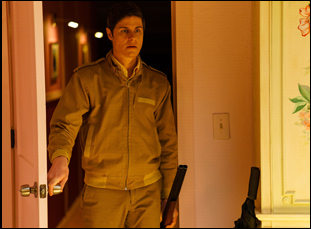
Sure, but this is the perfect movie to make on a small budget because it is so contained. There weren’t crazy logistics and when you work on smaller films, you wear a lot of hats, but as far as me helping on the sound design and doing the foley work and anything that I can do, it’s just fun to get your hands dirty and play with all the toys. So it wouldn’t matter if it was a low budget movie, I’d still want to be heavily involved in the sound design or the production design process, just because I love making films and all the different art forms that fall under that umbrella.
You also figure out a clever way to set the scene around this cabin by introducing the film with this sketch of the forest around it in the opening credits. How did that come about as an idea?
Well, I happen to be married to a brilliant illustrator and artist named Vanessa McKee, and she’s been involved in all of my films since “The Woods,” and I can communicate an idea to her and she understands it in a way that nobody else can. She can bring it to life very, very quickly, and it’s right on the button, and more often than not, a zillion times better than what I could have imagined. She really understands my taste and sensibility and can work in any style, so she drew this beautiful landscape for the beginning of the film. It’s always a pleasure, and there’s even some drawings by my son, Arthur, who was three years old at the time, kind of buried around the cabin, so it’s definitely a family affair.
Given all the extenuating circumstances, what was it like to get this in the can?
It was a huge sigh of relief that nobody got sick, because we shot this at the height of the pandemic and pre-vaccination, so we had to work in a bubble, and it was nerve-racking. We had to get tested every other day, and my biggest fear was that this horrible virus would rip its way through my crew when we were halfway through shooting. But it never happened. Paper Street Pictures and Marc Senter as producers really, really made sure that everybody was as safe as possible as we were going along, and then it was just a goddamn delight to work on the thing all the way through. That carried through through the post-production process with [sound designer] Andrew Smetek and [editor] Zach Passero and Ryan Orozco. Everybody was on their A game and there was a feeling it was a job well done.
“Old Man” opens on October 14th in select theaters, including the Laemmle Glendale in Los Angeles, on digital and on demand.

